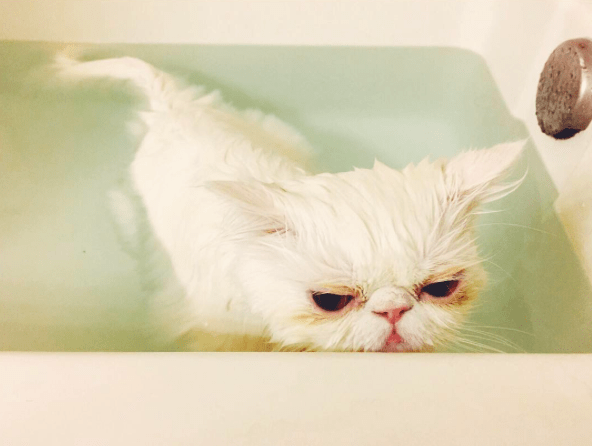
Cats are well known for their impeccable grooming habits, but every once in a while they need a little help, especially if your cat sometimes goes outdoors, has long hair, is elderly, or has special needs. As much as cats are known for their grooming habits, they’re equally well known for their hatred of getting wet. Taking the time to prepare and to learn some tricks in advance can go a long way in helping to minimize your cat’s anxiety, ward off a retaliatory attack, and make the experience as pleasant as possible for both of you.
1. Consider other options Before giving your cat a bath, be sure she really needs one. Since cats are self-cleaning, most cats won’t need to be bathed regularly. There’s no need to go through the effort of the bath and stress your cat out over something that’s not necessary. If your cat needs a little help but isn’t filthy, consider methods that are less drastic, like pet-friendly wet wipes or spot cleaning with a wet washcloth.
Related:
The 6 Most Essential Cat Grooming Products To Keep On Hand
2. Choose the right time
You can take a lot of stress away from bath time simply by choosing a time when your cat is naturally more relaxed. You can also “trick” your cat into being more relaxed by wearing her out with an exceptionally active play session before you need to bathe her.
3. Consider a calming supplement Calming supplements like Bach’s Pet Rescue Remedy were invented for times just like this. Always choose supplements that have been designed specifically for cats, since human versions can contain ingredients that may be toxic to your cat.
Related:
Manage Your Cat’s Anxiety With These 9 Tips
4. Prepare your cat’s claws
Even a sweet-tempered cat can claw and scratch when she feels threatened by a sink full of water. Bath time will be safer for both of you if you clip your kitty’s claws beforehand. If you don’t think you can snip them safely, try nail caps like Soft Paws.
Related:
Keep Your Cat’s Paws and Claws Healthy With These 5 Tips
7 Reasons To Never Declaw Your Cat
5 Cat-Friendly Alternatives To Declawing
5. Gather supplies Trust me, the last thing you need is to realize you’ve forgotten the shampoo or towel after you’ve set the bath game in motion. Gather everything you need in advance– including pet shampoo, a washcloth, large towel, a comb, and a non-breakable vessel (like a plastic pitcher or cup) for wetting your cat.
Related:
Tips For Stress-Free Grooming At Home
6. Brush your cat
Always brush your cat before bathing her. A bath will be most effective if you’ve pre-removed loose hair and debris.
Related:
7 Ways To Curb Cat Shedding In Your Home
7. Remain calm Cats look to their humans for clues about whether they need to be anxious about any given situation. If she can see that you’re stressed or anxious, she’ll feel that way too. Do everything you can to prepare for the bath, have a game plan, and stay cool and collected throughout the process.
8. Use a safe water vessel
If you have a water sprayer attached to your sink, that’s a great way to get your cat wet and rinse out shampoo. If you don’t have one, or if you’ll be washing your cat in a place that’s not your kitchen sink, you’ll need to use a pitcher or cup to pour water on your cat. Choose a plastic one that won’t break if it gets knocked out of your hand by a struggling cat.
9. Use warm water Paying attention to the temperature of the bath water isn’t just a matter of comfort for your cat– it’s also a matter of safety. Use water that’s lukewarm to keep your cat comfortable and safe.
10. Use a pet-friendly shampoo
Human shampoos can dry out your cat’s skin and many are made with ingredients that can be toxic to cats. Pet-safe shampoos will be specifically designed to keep your cat’s skin and coat healthy and moisturized.
11. Lather up and rinse well Lather your cat up from head to tail, gently massaging your cat to work it through her coat. Your cat will be the most comfortable if you work the shampoo in the same direction her hair grows in. Be careful to keep shampoo and water away from her face, eyes, and ears. NEVER dunk your cat’s head or face under water. Use clean water to rinse all of the shampoo from her coat, since residue can dry her skin and coat out.
12. Be gentle with the face
Don’t lather your cat’s face with shampoo, even if her face is dirty. Instead, gently rub her face with a washcloth that’s damp with clean water.
13. Dry safely Wrap your cat in a large, soft towel after the bath to soak up excess water. Keep her away from drafty areas while she’s wet. If your cat won’t mind the noise, you can use a blow dryer set on the lowest setting.
14. Comb long hair
Long haired cats have a tendency to get knots in their coats after baths. If this is the case for your kitty, she may need a post-bath combing.
15. Treats!
Giving your cat some treats after a bath can help convince her that the bath wasn’t so bad after all. At the very least, receiving something delicious may convince her that the bath was worth the hassle. You’ll be in a better position next time if your cat learns to associate the bath with something delicious and pleasurable at the end.



